 PEOPLE AND CULTURE PEOPLE AND CULTURE |
 I.Montenegrin way of life I.Montenegrin way of life |
The Montenegrin way of life for centuries was influenced by wars, and struggle against the conquerors and other enemies. This struggle has lasted for more than half a millennia and was fought very often against armies, way better equipped and much more numerous. Many times the people of Montenegro were forced to withdraw from their lands into the barely passable mountains, abandoning their houses and cities. This, naturally, in the long run brought the fall of the level of their civilization. Even at the beginning of the 19th century there were no towns or cities in Montenegro that could be compared to the ones in Europe. The explanation for this lies in the history of the country that always had to be prepared for the attacks of the then Great Powers. Art, literature and science were not developing, and the main attributes of a typical Montenegrin were: a sword, a gun and a bible.
These conditions of life had also influenced the physical characteristics of the nation. Even modern science admits that the people from this part of the world are different from the rest of Europe, have strong constitution and above average height. Montenegrins are on average the tallest in Europe.
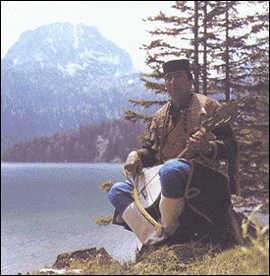
- A "gusle" player from Durmitor -
"Montenegrins are by nature and character as hard as their rocks. Tall, well-built, of iron constitution; they have a warrior spirit, which they instill from an early age, they develop unusual strength."
Francois Lenorman (1837-1883), French scientist
There has always been a strict hierarchy of authority: the father, the elders, tribal chief, ruler, and they all upheld the military spirit of the time. Patriarchalism, collectivism and traditionalism are the basis of the Montenegrin philosophy of life.
Another important part of their national identity is the love for freedom, but especially the willingness to fight for it and paying for it the highest possible price.
"By character and temperament Montenegrins, like the majority of highlanders, are hospitable and kind towards strangers and have friendly feelings towards those who agree with their high ideals about independence and devotion to one's country."Sir John Gardner Wilkinson (1797-1875), British archaeologist
For a long time there was only one certainty in the life of every Montenegrin, that there would be wars where they would need to fight. There was even a tradition of organizing special celebrations when a male child was born, to mark that the country had received one more defender, and moreover a gun was usually put on the cradle of the baby to make him get used to what he will be doing. To die on the battlefield fighting for the fatherland was an honor and even man as old as 100 years would consider it their duty. The idea of patriotism was also very popular among women. Some of them fought along with the men, while others were taking care of the house and helping their fathers, brothers, or sons in every possible way.
Montenegro nowadays still keeps alive the memory of its heroes. An interesting fact is, that there is no monument to the Unknown Soldier here, since they all fought heroically and made their names known across the country.
"Montenegro undoubtedly takes one of the first places; the legendary heroism of her people brings honour to mankind."
Giuseppe Garibaldi (1807-1882), Italian politician
The geographic position at the crossroads between the East and the West rendered Montenegro to be the scene of tumultuous historic events over centuries, and the place where various people and religions met, existed and merged. Specific cultural and historic heritages as well as the characteristics of the territory on which they crossed, resulted in the formation of the multiethnic, multicultural and multi religious community in Montenegro.
 II. Population of Montenegro II. Population of Montenegro |
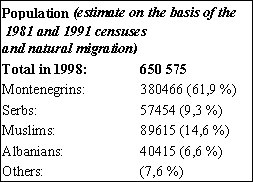



 III. Language III. Language |
The official language in Montenegro is Serbian. It belongs to the South-Slavic family of languages.
The standard Montenegrin idiom is based on ijekavian neoshtokavian dialect. In Montenegro, two dialects are in use differing from each other in stress and declension. Furthermore, two alphabets, both Cyrillic and Latin are equally used in the territory of the country.
The Montenegrin alphabet is phonemic: each sound is represented by a single letter. But in addition to the 30 phonemes making up the standard spoken language with the corresponding number of letters in the written language, several more phonemes can be heard.
In the areas where the Albanian minority makes the majority of population, the use of their native language is guaranteed by the Constitution.
 IV. Sports IV. Sports |
Sports have been traditionally cherished in Montenegro. Numerous worldwide famous sportsmen are coming from this area. Modern sports in Montenegro were established at the beginning of this century and present the continuation of the tradition of knightly arts of battle. First competitions and construction of sports fields are related to this period of time, and they are the merit of Montenegrin court and diplomatic missions in the Duchy of Montenegro of that time.
Nowadays, numerous sports events take place in Montenegro:
- bicycle race "The Roads of King Nikola" /Montenegro-Italy
- Podgorica's Marathon,
- Car race "Lovcen"
- Women volleyball tournament "Port cup",
- Dives from the Vezir bridge
- Beach volleyball /Ulcinj, Becici/ during the whole summer
- Swimming marathons along the coast
- Yugoslav and international regattas
… and different sorts of competitions in water polo, basketball, handball, football, kick box, karate…
The assessment of one's skill, strength and agility was the favorite pastime of the Montenegrin youths ever since. At the end of the 19th century, tennis, football and golf were played in Montenegro, and also popular were skating, skiing, fencing, cycling and equestrianism. In the early 20th century were the first sport clubs founded. In 1908 Montenegro received the official invitation from the English king Edward VII to take part in the Olympics in London, but since it was not the member of the International Olympic Committee it could not participate.
Today, sport in Montenegro is a significant social activity; in more than 650 sport clubs around 35,000 athletes train or compete permanently or occasionally. Montenegro produced many top sportsmen - World Investment News Ltdrs of medals in the Olympic games, or in European, world and other great international competitions. The European and world sports publics are well acquainted with the achievements of:
 Football players Football players |
Dejan Savicevic, Predrag Mijatovic, Dragoje Lekovic, Ljubomir Radanovic, Ivica Kralj;
 Basketball players Basketball players |
Zarko Paspalj, Dusko Ivanovic, Radovan Radovanovic, Rajko Zizic, Vlado Scepanovic, Nikola Bulatovic;
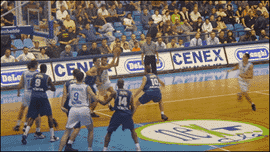
- September 2001, Buducnost against Cebona -
 Volleyball players Volleyball players |
Miodrag Gvozdenovic, Goran Vujevic, Vladimir Batez, Igor Vusurovic;
 Handball players Handball players |
Veselin Vujovic, Pero Milosevic Blazo Lisicic, Petar Kapisoda;
 Female handball Female handball |
Olga Pejovic, Ljiljana and Svetlana Mugosa, Dragana Pesic Maja Bulatovic;
 Water polo players Water polo players |
Dragan Stanisic, Trifun Cirkovic, the Vicevic brothers, Zoran Gopcevic, Andrija Popovic, Veljko Uskokovic;
 Boxer Boxer |
Miodrag Perunovic;
 Judist Judist |
Dragomir Becanovic;
 karate champions karate champions |
Bato Ognjenovic and Samir Usenagic; many others.
The clubs themselves achieve noted results in Yugoslav and European competitions. The most successful ones are:
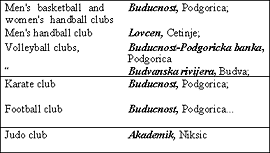
Montenegro hosted the European championships in target shooting and karate.
Montenegro submitted its candidature for the organisation of the "Mediterranean games". Football stadiums in Podgorica, Berane, Cetinje, Niksic, Budva and Tivat satisfy the high world standards, and so do the swimming/waterpolo pools in Kotor and Herceg-Novi, there are also numerous tennis courts built beside the hotels and other tourist facilities. Moreover, large sport arenas are under construction in Herceg Novi, Pljevlja and Kolasin, together with the Olympic-size pools in Niksic and Budva; excellent sports halls already exist in Podgorica, Niksic, Budva and Tivat.
The system of sports development in Montenegro is realized on the premises and experiences of the developed European countries and the Charter of the International Olympic Committee.
The Ministry of Sports of the Montenegrin Government was founded in 1993. |  V. Culture during the State of Zeta V. Culture during the State of Zeta |
"…What attracted me was what I saw when I got there the light of history is forged, where the spirit and fantasy find their richest food, where life only half resembles reality and more resembles a multifaceted fairy tale, if not a new edition of the "Lliad" "
Jozef Holececk (1853-1939), Czech author and journalist
The oldest written document preserved from the early state of Zeta is the Genealogy of Bar dating from the 12th century, referred in scientific circles as the Chronicle of Pope Dukljanin. The original has not been preserved. There is enough evidence to indicate that it was written in Slavic. Only one copy of the Latin translation, which was discovered in Bar, has been preserved. The Chronicle, though not very reliable, is the sole source of information for the early period in the history of Zeta. It contains traditions testifying to the existence of different forms of poetry.
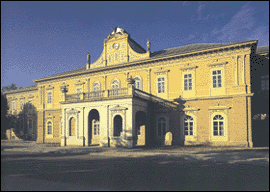
- The State Museum in Cetinje-
The Genealogy also includes individual documents of which originals have not been preserved.
Individual forms of written literature, mainly prayer-books and liturgies, have been discovered in the coastal towns of Budva, Bar, Ulcinj, Kotor and Perast for the churches erected there. Some of them contain the hagiographies of saints to whom they are dedicated. The most renown shrines dating from that period are the church of St Trifun in Kotor (809), the church of St Mihailo in Ston (late 10th and early 11th centuries) and the St Toma church in Kuti (11th century).
The churches were erected mainly in the Roman or Byzantine styles until 1228 and the appearance of Franciscans who endeavoured to introduce their own style. Unfortunately, only fragments of the paintings have been preserved.
Culture during the period of the Nemanjics: Some of the most outstanding literary works and artistic monuments of the Nemanjic era were created in Zeta, above all Miroslav's Gospel, written in 1180 for Prince Miroslav of Hum. It was written on parchment, adorned with miniatures and initials in color, and accompanied by illustrations, which make up a masterpiece for many subsequent periods. It was written as a liturgical book. The church is one of the first endowments erected by a Nemanjic in these spaces, and also one of the first monuments erected in this territory during the renaissance of the Palaeologus dynasty.
Another significant piece of literature is Vukan's Gospel dating from the late 12th and the early 13th centuries. now kept in Leningrad. Illustrated with elaborate initials, miniatures, letters in different colors, it is significant both as an artistic and as a literary record of its date.
The Collection of Father Dragoje , written at about the same time, contained various traditions, legends and anecdotes and was characteristic of the medieval period. Unfortunately, mere fragments published by Panta Sreckovic supplemented by his brief descriptions tell us all we know about this work, as it was burnt away on April 6, 1941 in the National Library in Belgrade.
Whenever they ruled, the Nemanjic rulers left behind many churches and monasteries as their endowments. Above all, the church of St Petar in Bijelo Polje, erected between 1124 and 1166. The church was built for nearly 40 years and contains traits distinctive of a transitional period in art in which various styles and epochs were mingled. Another significant building of the Nemanjic epoch is the monastery of Djurdjevi Stupovi (Djuradj's Columns) of 1219. In addition to rich paintings inside, characteristic of this period of the Nemanjic epoch, the exterior is elaborately decorated in plastic. The monastery of Moraca, completed in 1252. is much simpler on the outside, but its frescos are a tribute to the medieval painting. Unfortunatelt not much has been preserved of the unique paintings and frescoes, since for over 70 years in the 16th century the interior of the church was exposed to the sky, as its lead roof was taken off by the Turks.
The existence of an art school in Kotor whose masters were mainly Franciscans is concordant in time with the period of the Nemanjic rule in Zeta. The masters in Kotor also painted frescos and were good architects. The most renown master from Kotor was Fra Vito Kotoranin, who painted the endowment of King Stefan Decanski, the monastery of Visoki Decani, mingling Byzantine tradition with new trends in painting.
The first Montenegrin book was printed five hundred years ago, the first printing press, located in Cetinje, was working in 1495 already, printing out the first copy of the South Slavic book.
The coastal towns of Ulcinj, Bar, Budva, Koto r are all ancient settlements and are the representatives of the fine architecture of that period. Budva is the oldest town on the Montenegrin coast, its age estimated at approximately 2500 years. Sophocles made the first reference to Budva in the 5th century BC.
 VI. Famous Montenegrin Painters VI. Famous Montenegrin Painters |
 Filip Jankovic (1935) Filip Jankovic (1935) |
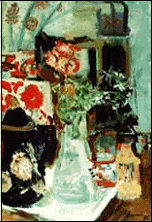
Born in August 1935 in Donja Gorica near the town of Podgorica.
In 1964 he moved to Belgrade, graduated from the Academy of Fine Arts. He was a student in the Ljubica Sokic, Marko Celebanovic, Milo Micunovic class.
His works are displayed in galleries and private collection in the country and abroad. He is the World Investment News Ltdr of a series of international awards.
Individual Exhibitions
1962 Titograd
1964 Titograd, Belgrade
1966 Niksic
1969 Cetinje
1974 Titograd, Gornja Gorica, Budva, Belgrade
1978 Kotor
1982 Titograd
1983 Sveti Stefan
1984 New York, Kotor, Tivat, Herceg Novi
1987 Belgrade
1988 Stuttgart
1989 Mannheim, Speyer
1990 Mannheim
1993 Podgorica
1996 Podgorica
 PETAR LUBARDA (1905-1974) PETAR LUBARDA (1905-1974) |
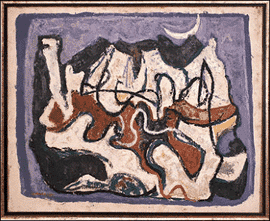
<- Night in Montenegro, 1951 -
For his work of painting and influence he had on development of post-war painting in former Yugoslavia, Petar Lubarda (Cetinje, 27th July 1907 - Belgrade, 13th Feb. 1974) is the artist of outstanding importance. He started his studies of painting at Artistic School in Belgrade in 1925, and already in 1926 he went to Paris where he studied painting independently in Parisian museums and galleries and participating occasionally in group exhibitions. His first independent exhibition was opened in Rome in 1929. In 1937 he participates in the international exhibition in Paris, where he obtains the Grand Prix prize. He is one of the founders of the first Artistic School in Montenegro, also being one of its teachers. In 1951 he opens a historical exhibition in Belgrade, which meant a radical modernist split with soc-realistic style in painting in former Yugoslavia. After the success of the exhibition in Belgrade, he opens two independent exhibitions in Paris. He is a World Investment News Ltdr of a number of international awards, such as: International Redemptory Award on the 2nd Biennial in Sao Paolo in 1953, First Prize on biennial in Tokyo 1955, Herdevora Award in Vienna 1973. He had study tours in India, France, Spain, Italy, Germany, Soviet Union, Brazil, England, Belgium, Syria and Lebanon.
 BRANKO FILIPOVIC- FILO (1924- 1998) BRANKO FILIPOVIC- FILO (1924- 1998) |
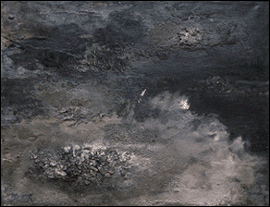
Composition, 1959
1924 born in Cetinje; 1942 - 1943 internated in Kavai/Albania; 1946 - 1950 studied at Art Schools Cetinje and Herceg Novi; 1955 finished Academy of Fine Arts, Belgrade; between 1958 and 1971 several times in Rome and Paris; 1997 died in Belgrade.
Solo exhibitions and participations (selection): 1953, 1956 Artists Pavilion, Belgrade. 1957 Gallery ULUS, Belgrade. 1965 Palace of Fine Arts, Brussels. 1970 "Contemporary Art of Montenegro 1945 - 1970", Museum of Contemporary Art, Belgrade. 1971 "Art on Yugoslav Territory from Prehistory until Nowdays", Grand Palace, Paris. 1971/72 "Abstract Painting in Serbia 1951 - 71", Gallery of Cultural Centre, Belgrade. 1980 Gallery Yvon Lambert, Paris. 1982 "Informel in Belgrade", Artists Pavilion, Belgrade.1987 Museum of Contemporary Art, Belgrade. 1990 Biennial of Venice. 1991 Biennial of Cetinje. 1996 "Stations of Montenegrin Modern Art", Exhibition Palace, Rome. 1997 retrospective, National Museum of Montenegro, Cetinje.
 VOJO STANIC (1924) VOJO STANIC (1924) |
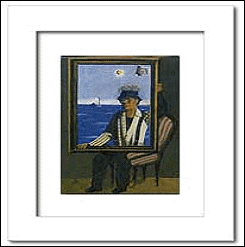
- A Self Portrait -
Born in 1924 in Podgorica; graduated from the Art Academy of Belgrade, department of sculpture. He taught at the School of Applied Arts in Herceg-Novi for many years. He lives and creates as a free-lance visual artist in Herceg-Novi. A member of the Academy of Science and Art of Montenegro.
This artistic expression is marked by warm and sincere poetry the sources of which spring up from primitive sensation and rise to grotesque and irony.
In 1997 he exibited at the Biennal of Venice
 VII. Culture and Education nowadays VII. Culture and Education nowadays |
Culturally Montenegro belongs to the Mediterranean and Panonian-Danubian heritage, it has been exposed to a strong Central and Eastern European influence. Today the Country accumulates the pre Romanesque, Gothic and Baroque periods.
Montenegro has its own Academy of Arts and Science, University, National Theatre, State Archives, Naturalist, Nautical and Archaeological Museum.
There is a compulsory 8-year education system that includes the history and culture of all ethnic groups living on the territory of the Republic. The education is of great importance and is of equal quality for all regardless of nationality or belief.
The language of instruction is Serbian and Albanian in some elementary schools.
Public schools are free of charge and are financed from the republic budget. |

